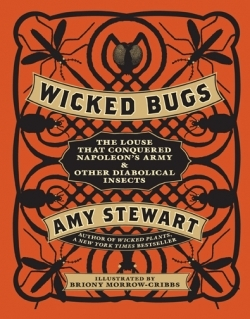Wicked Bugs
Wicked Bugs is a good example of what a natural science book should do: that is, integrate many different disciplines—history, biology, chemistry, medicine, and art—into an accessible, well-written package. In this case, a small one that packs a wallop.
Amy Stewart loosely uses the term “bug” to describe insects having six legs, arachnids having eight legs (spiders and scorpions), and parasites such as tapeworms. Fans of Animal Planet’s “Monsters Inside Me” will surely shudder at the last term; and, indeed, there is much shuddering to be done throughout this enjoyable little book. Each of the over one hundred entries features a beautiful etching by Briony Morrow-Cribbs, followed, in encyclopedic fashion, by the odious critter’s scientific name, size, family habitat, and distribution details.
Hair-raising anecdotes include information about the bug’s behavior, history, and victims. For instance, the section on Stinging Caterpillars chronicles a story of a twenty-two-year-old woman who received a painful sting on her foot in Peru. The pain radiated up her leg and she got a headache, but felt well enough the next day to return home to Canada. Before long, however, she noticed large bruises forming. Scientists identified a species from Brazil, but before an antivenin could be sent, she died. The most likely killer was the fire caterpillar, who, when aroused, will release a powerful toxin that causes massive internal bleeding and organ failure. In nearby pages we also meet the Puss Caterpillar of southern North America. Said to look like a small Persian cat, the resemblance to a cozy feline stops there: the pain reportedly produced by brushing against it is described as like being hit by a hammer.
Those who have ever wondered who the real king of the jungle is will quickly come to the conclusion while reading Wicked Bugs that it’s not the elephant or the lion, but a small driver ant from Central and East Africa. These bugs have been known to move in swarms of twenty million strong, wiping out every other insect in their path and making larger animals respect their territory.
Stewart also introduces us to the most deadly creature on our planet: a lowly mosquito known as Anopheles. Responsible for millions of deaths each year through the transmission of malaria, mosquitoes also transmit about one hundred other human diseases. Tests on the insects preserved in amber show evidence of malaria thirty million years ago.
While the book’s tone has an appealing levity, the information conveyed makes even the most squeamish reader respect the capability of these bugs as potent forces not to be played with. Did I mention that bookworms have devoured whole libraries?
Reviewed by
Ed Eakin
Disclosure: This article is not an endorsement, but a review. The publisher of this book provided free copies of the book to have their book reviewed by a professional reviewer. No fee was paid by the publisher for this review. Foreword Reviews only recommends books that we love. Foreword Magazine, Inc. is disclosing this in accordance with the Federal Trade Commission’s 16 CFR, Part 255.

